Diwali celebrations bring families together through rich traditions, vibrant colors, and memorable photographic opportunities. Key practices include lighting diyas, creating rangoli, and sharing festive meals. The festival’s colors symbolize prosperity and joy, enhancing the celebratory atmosphere. Photographic moments capture the essence of Diwali, from family gatherings during puja to dazzling fireworks displays.
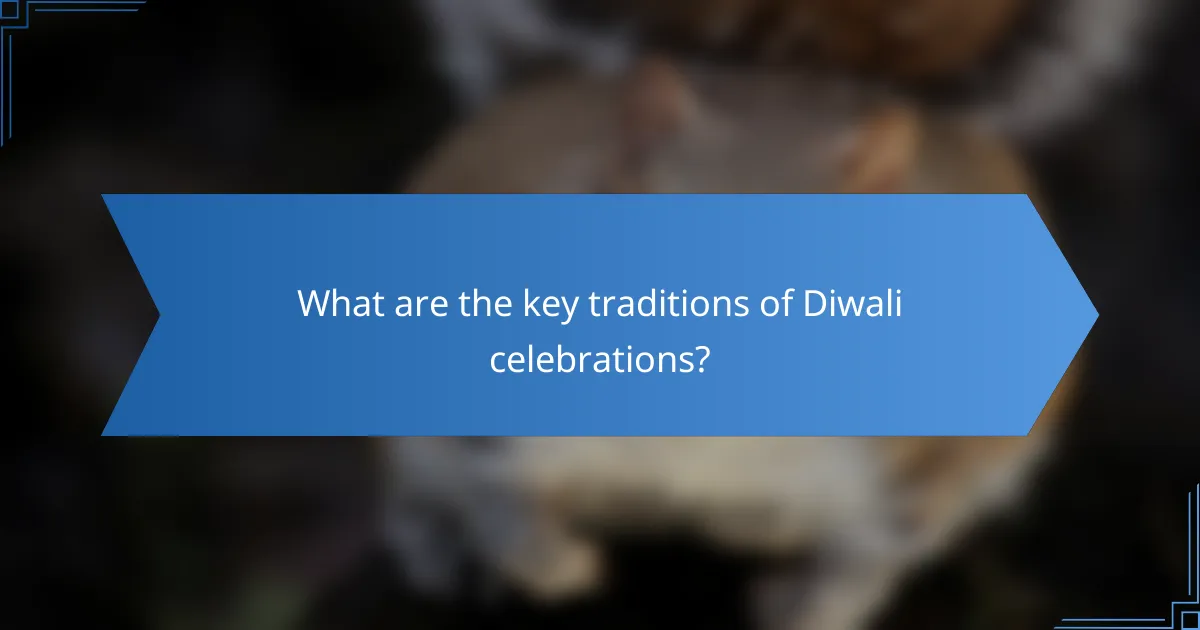
What are the key traditions of Diwali celebrations?
Diwali celebrations feature several key traditions, including the lighting of diyas, decorating homes with rangoli, and exchanging gifts. These practices symbolize the victory of light over darkness and good over evil. Families gather for prayers, known as puja, to honor deities like Lakshmi and Ganesha. Festive meals and sweets, such as ladoos and barfis, are shared, enhancing the spirit of togetherness. Fireworks display vibrant colors, marking the joyous occasion.
How do different regions celebrate Diwali uniquely?
Different regions celebrate Diwali with unique customs and traditions. In North India, families perform elaborate pujas and light diyas to honor Lakshmi, the goddess of wealth. In South India, the festival often marks the victory of Lord Krishna over the demon Narakasura, celebrated with fireworks and feasts. In West India, particularly Gujarat, the festival includes vibrant garba dances and colorful rangoli designs. East India emphasizes the worship of Kali, featuring night festivities and traditional sweets. Each region showcases distinct cultural expressions, making Diwali a diverse celebration across India.
What rituals are essential during Diwali?
Essential rituals during Diwali include lighting diyas, performing puja, exchanging gifts, and enjoying festive meals. These practices symbolize the triumph of light over darkness and foster community spirit.
1. Lighting diyas and candles: Represents the victory of light.
2. Performing Lakshmi puja: Invokes blessings for wealth and prosperity.
3. Exchanging gifts and sweets: Strengthens relationships and goodwill.
4. Decorating homes: Enhances the festive atmosphere.
5. Fireworks and celebrations: Marks joy and festivity in the community.
Why is Diwali considered a festival of lights?
Diwali is considered a festival of lights because it symbolizes the victory of light over darkness and good over evil. Celebrated by millions, it features the lighting of oil lamps, fireworks, and colorful decorations. This tradition stems from various mythological stories, including the return of Lord Rama to Ayodhya after defeating Ravana. The illumination during Diwali represents joy, prosperity, and the hope for a brighter future.
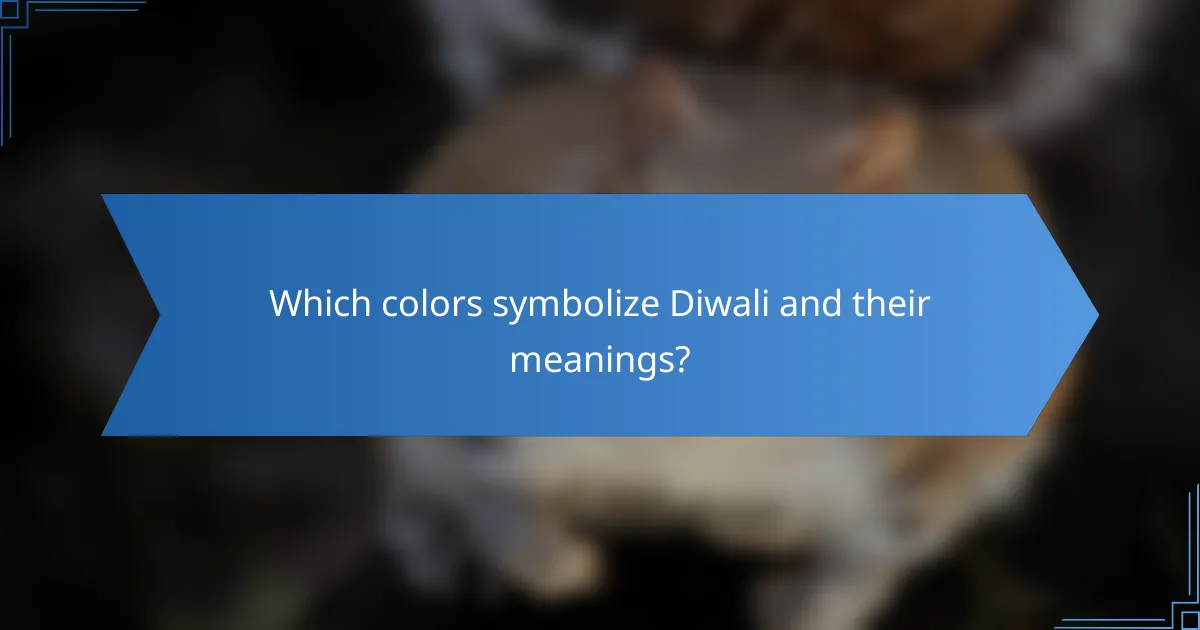
Which colors symbolize Diwali and their meanings?
The colors that symbolize Diwali include bright hues like gold, red, green, and blue, each carrying specific meanings. Gold represents wealth and prosperity, red signifies joy and celebration, green symbolizes renewal and growth, and blue reflects peace and tranquility. These colors enhance the festive atmosphere and embody the spirit of the festival.
How do colors influence the decorations during Diwali?
Colors significantly influence Diwali decorations by symbolizing joy, prosperity, and spirituality. Bright hues like red, yellow, and orange are commonly used to evoke festive energy, while blue and green represent tranquility and harmony. Each color selection enhances the celebratory atmosphere and reflects cultural significance. For example, marigold flowers, often orange or yellow, are popular for their association with auspiciousness. As a result, the vibrant color palette creates a visually stunning environment that enhances the overall Diwali experience.
What is the significance of Rangoli in Diwali celebrations?
Rangoli holds significant cultural importance during Diwali celebrations as it symbolizes prosperity and welcomes guests. The vibrant colors and intricate designs reflect creativity and devotion. Traditionally, families create Rangoli at their doorsteps to invite positive energies and deities into their homes. This practice also fosters community bonding as neighbors admire each other’s art.
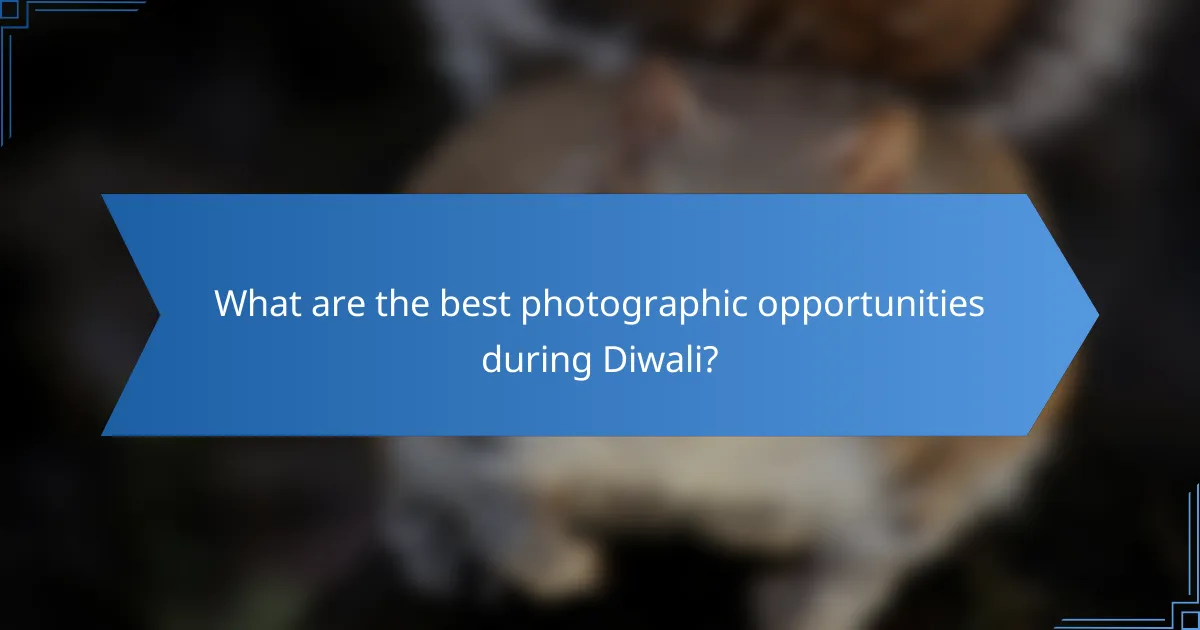
What are the best photographic opportunities during Diwali?
Diwali offers numerous photographic opportunities that capture its vibrant essence. Key moments include the illumination of homes with diyas, the colorful rangoli designs at entrances, and the festive fireworks that light up the night sky.
Additionally, capturing family gatherings during puja rituals showcases the spirit of togetherness. The exchange of sweets and gifts provides candid moments filled with joy. Street scenes adorned with decorations and bustling markets add to the visual narrative, highlighting the cultural richness of the festival.
To enhance your photography, consider the golden hour for natural lighting and experiment with different angles to capture the festivities’ dynamic energy.
Which events during Diwali are most photogenic?
The most photogenic events during Diwali include the lighting of diyas, fireworks displays, and the colorful rangoli designs. Each of these elements creates vibrant visuals, perfect for photography.
1. Lighting of Diyas: The warm glow from countless diyas creates enchanting scenes, ideal for capturing the festive spirit.
2. Fireworks Displays: The night sky illuminated with fireworks offers dramatic contrasts and dynamic shots.
3. Rangoli Designs: Intricate and colorful patterns made from colored powders provide rich textures and colors for striking images.
4. Family Gatherings: Candid moments during family celebrations capture genuine emotions and connections.
5. Festive Feasts: The presentation of traditional foods showcases culture and adds appetizing visuals to your collection.
How can you capture the essence of Diwali through photography?
To capture the essence of Diwali through photography, focus on vibrant colors, intricate decorations, and emotional moments. Highlight traditional elements like diyas, rangoli, and family gatherings. Use natural light to enhance the festive atmosphere. Experiment with angles to create depth and convey the joy of the celebrations. Capture candid interactions to showcase the spirit of togetherness.
What tips can enhance your Diwali photography experience?
To enhance your Diwali photography experience, focus on planning, lighting, and composition. Select vibrant backgrounds that reflect the festival’s colors. Use natural light during the golden hour for soft, warm tones. Capture moments of joy, rituals, and decorations to tell a story. Experiment with angles and perspectives for unique shots.
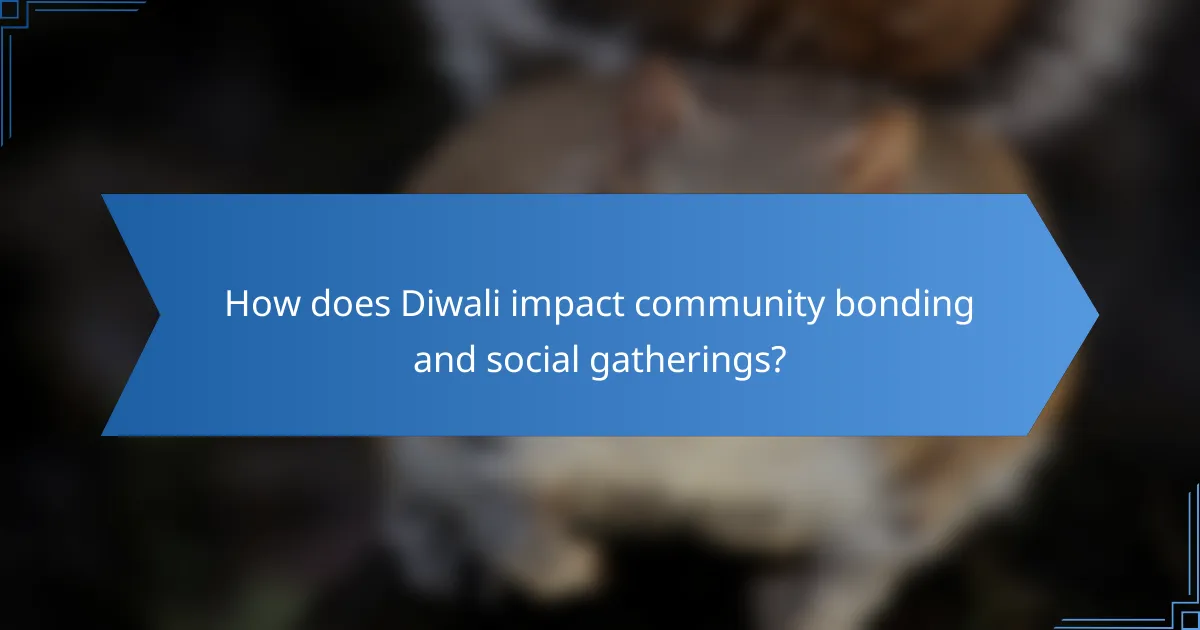
How does Diwali impact community bonding and social gatherings?
Diwali fosters community bonding and social gatherings through shared celebrations and cultural traditions. Families and friends come together to decorate homes, exchange sweets, and participate in rituals, strengthening social ties. The festival’s vibrant colors and lights create an inviting atmosphere, encouraging communal participation. Events such as community feasts and fireworks enhance social interactions, promoting unity and joy among diverse groups. As a result, Diwali serves as a powerful catalyst for reinforcing connections within communities.
What role do family gatherings play in Diwali celebrations?
Family gatherings are central to Diwali celebrations, fostering connection and joy. These events allow families to share traditional meals, participate in rituals, and exchange gifts. The collective experience strengthens familial bonds and creates lasting memories. Additionally, the vibrant atmosphere of Diwali, characterized by decorations and lighting, enhances the significance of these gatherings. Celebrating together during this festival reinforces cultural values and traditions passed through generations.
How do local communities engage in collective Diwali festivities?
Local communities engage in collective Diwali festivities through shared traditions, vibrant decorations, and communal activities. These celebrations often include group prayers, community feasts, and cultural performances that strengthen social bonds.
Festivities are marked by the use of colorful rangoli designs, which adorn homes and public spaces. Fireworks and lighting of diyas create a festive atmosphere, enhancing the sense of unity.
Additionally, many communities organize events such as fairs and parades, showcasing local talent through music and dance. These gatherings foster a spirit of togetherness and cultural pride.
Overall, collective engagement during Diwali not only celebrates the festival but also reinforces community ties and shared heritage.
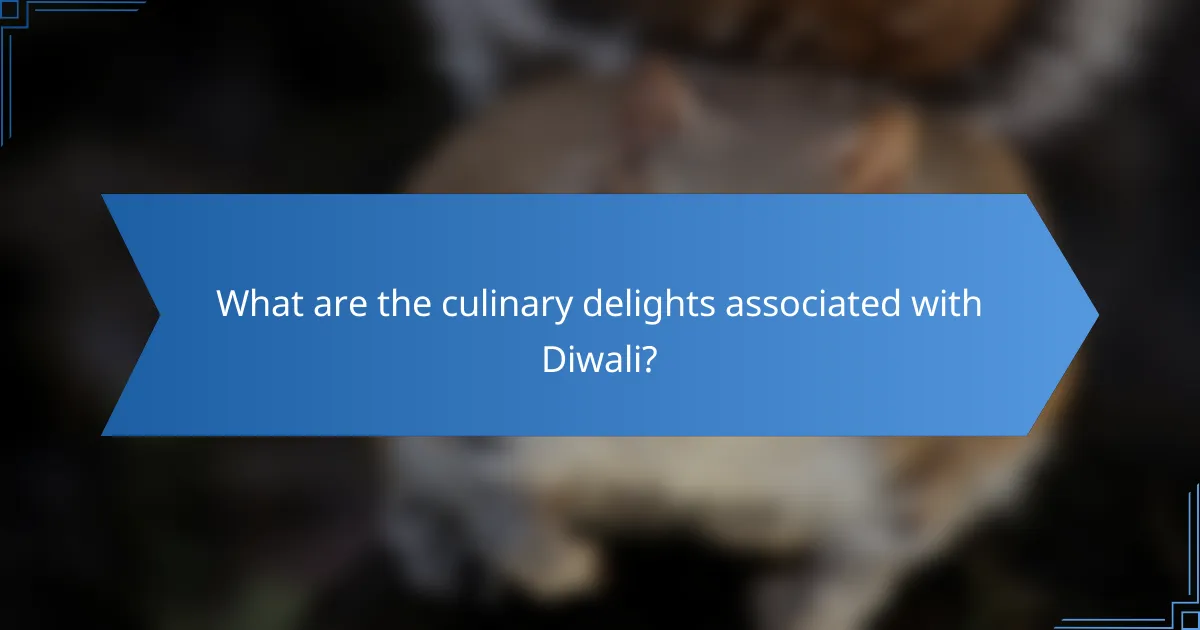
What are the culinary delights associated with Diwali?
Diwali celebrations feature a variety of culinary delights, including sweets, snacks, and festive meals. Traditional sweets like ladoos, barfis, and jalebis symbolize joy and prosperity. Savory snacks such as samosas and chaklis are popular for sharing among family and friends. Meals often include rich dishes like biryani and paneer curry, reflecting the festive spirit. Each dish carries cultural significance, enhancing the overall celebration.
Which traditional sweets are must-try during Diwali?
Must-try traditional sweets during Diwali include gulab jamun, jalebi, barfi, and laddoo. These treats embody the festive spirit and are often shared among family and friends.
Gulab jamun features soft, spongy balls soaked in sugar syrup. Jalebi is a crispy, spiral-shaped sweet, often enjoyed warm. Barfi, made from condensed milk, comes in various flavors like pistachio and coconut. Laddoo, typically made from chickpea flour, is a popular choice for celebrations.
Each sweet has unique attributes that enhance the Diwali experience, making them essential for the festivities.
How do food offerings enhance the Diwali experience?
Food offerings significantly enhance the Diwali experience by fostering community connections and symbolizing prosperity. Traditional sweets and snacks, such as ladoos and samosas, are shared among family and friends, reinforcing social bonds. The vibrant colors and intricate designs of these foods also contribute to the festive atmosphere. Moreover, specific dishes hold cultural significance, representing various regional traditions and adding depth to the celebration. The act of preparing and sharing food creates memorable moments, making Diwali a time of joy and togetherness.
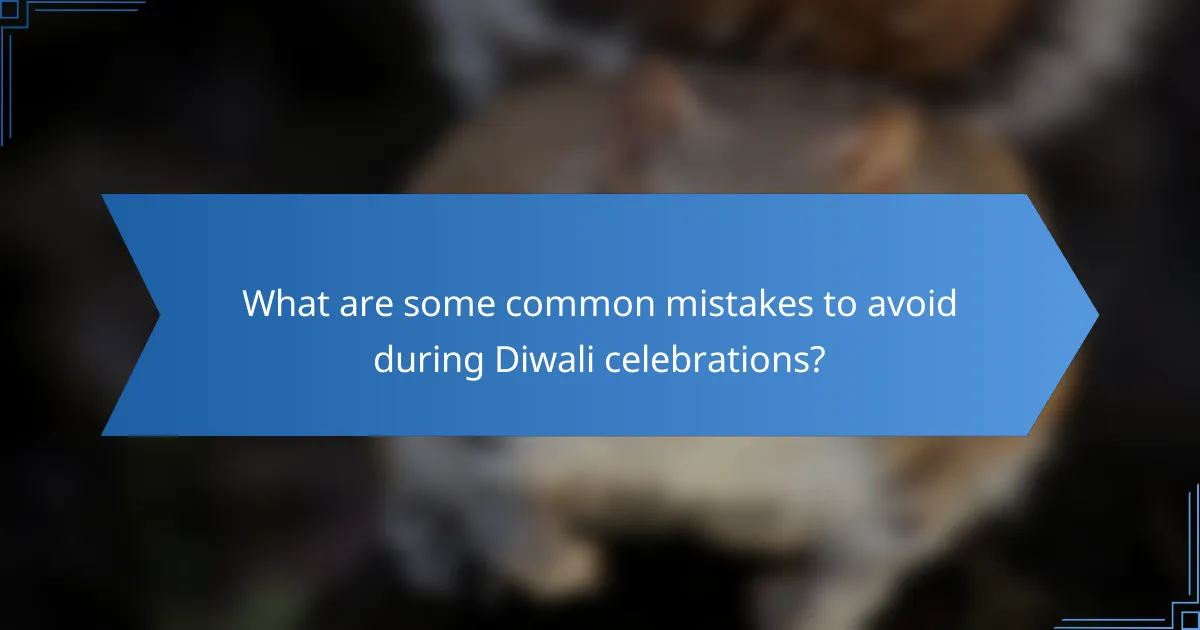
What are some common mistakes to avoid during Diwali celebrations?
Common mistakes to avoid during Diwali celebrations include neglecting safety measures, overspending on decorations, and not planning for dietary restrictions.
Forgetting to prioritize safety can lead to accidents with fireworks or candles. Overspending can create financial strain, detracting from the joy of the festival. Additionally, failing to consider guests’ dietary preferences may leave some feeling excluded.
Being mindful of these aspects can enhance the Diwali experience for everyone involved.
How can you ensure a safe and enjoyable Diwali for all?
To ensure a safe and enjoyable Diwali for all, prioritize safety measures and inclusive practices. Start by using eco-friendly materials for decorations and fireworks. Encourage community participation in celebrations to foster togetherness.
1. Choose safe, non-toxic colors for Rangoli and decorations.
2. Opt for noise-free fireworks to minimize disturbances.
3. Organize community events that welcome diverse participation.
4. Educate children about fire safety and responsible celebrations.
By implementing these steps, you enhance the festive spirit while ensuring safety and enjoyment for everyone involved.
What are best practices for sustainable Diwali celebrations?
To celebrate Diwali sustainably, focus on eco-friendly practices. Use natural decorations, such as flowers and clay diyas, instead of plastic. Opt for organic sweets and local produce to minimize carbon footprints. Choose noise-free fireworks or none at all to reduce pollution. Encourage community gatherings to share resources and promote cultural exchanges.